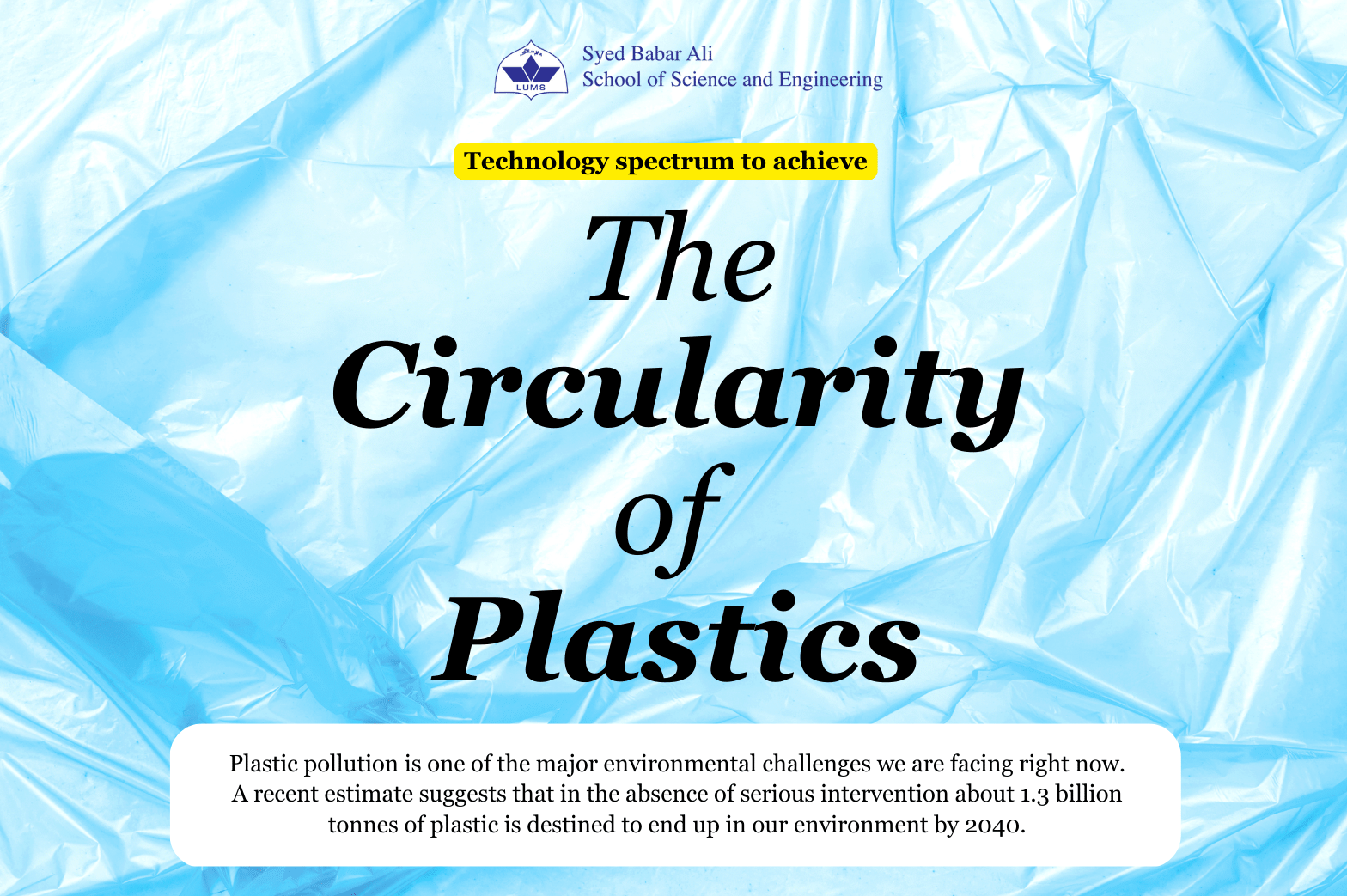
Technology spectrum to achieve “The Circularity of Plastics”
Plastic pollution is one of the major environmental challenges we are facing right now. A recent estimate suggests that in the absence of serious interventions about 1.3 billion tonnes of plastic is destined for our environment by 2040. Such is the magnitude of the challenge, and it is, therefore, no surprise that actions are being taken at individual, community, government, and corporate levels for developing technological and social interventions to mitigate the impact of the plastics that have already entered the environment and to stop more plastics from entering the environment in future. The ultimate goal of all the plastic pollution controlling interventions is to achieve “the circularity of plastics”, which encompasses efficient use of plastic products keeping them in use for a long period of time and, as they reach end of their life, converting them into materials that could be used to produce same plastic or other products ensuring zero plastic waste emissions. Among the most obvious plastic pollution controlling strategies is something we’ve all been taught from a young age: the three R’s - Reuse, Reduce, and Recycle.
Reuse: Reusing plastic is as easy as it sounds such that every individual can start from their own rooms, houses, cars and collect all those disposable plastics and turn them into something that keeps them from ending up in the environment. By simply reusing plastic products one can contribute to the efforts targeted at keeping the widespread pollution in check. Plastics do not just come in the forms of bags and bottles, the polyester used in textile is a synthetic plastic, therefore, finding a way to reusing our clothes is a valid strategy to impede plastic pollution. The most notorious culprits in context of plastic pollution are the famous single use plastic bags. Having recorded a staggering 55 billion polyethylene (PE) plastic bags use annually in Pakistan and 5 trillion globally, initiatives of varying degrees in intensity are being conceived and implemented to control plastic pollution originating from single use plastic bags. Interestingly, the non-woven polypropylene (PP) bags with a fabric feel have emerged as an alternative to the polyethylene bags. However, it is important to understand that this alternative is still a plastic and has the same environmental consequences. The hope here is that the higher expense of non-woven PP bags will incentivize their reuse.
Reduce: Reducing the production of plastics can also help in controlling the amounts of plastics entering the environment. Around the world, bans of different extents have been implemented on plastic products to reduce the rates of plastic waste generation. Banning single use plastic bags seems to be the most explored strategy. For instance, 5 years after a single-use plastic bags ban was in effect, Italy saw a 55% reduction of plastic bag pollution along the coast of the Mediterranean Sea. Beside plastic bags and bottles, disposable plastic cutlery made up of polystyrene (PS) and PP is another contributor to accumulating plastic waste. In context of Pakistan, different extents of policy making and implementation are in progress. Although current efforts in Pakistan are not encompassing any product other than the single-use-plastic-bags, other regions in the world are taking more holistic approaches. Since July 3, 2021, the member states of European Union have implemented a total ban on disposable plastic cutlery. Beside European States, Peru has implemented a ban on the single use plastic cutlery since 2019, which is expected to reduce an over the top 0.947 million tons of plastic use every year. In North America region, eight states of the USA have banned the single use plastic bags. These include New York, California, Vermont, Connecticut, Hawaii, Delaware, Maine, and Oregon. Washington DC has banned use of plastic straws or stirrers. Similarly, Canada is imposing bans on several single use plastic products. These are some examples of the efforts made by different regions in the world to reduce the production and use of single use plastics. A challenge that counters the implementation aspect of most of the efforts focused on reducing the production of plastic products is its impact on the industry and economy. Several large-scale industries, which are the backbone of the economy of any region, rely on the petroleum-based plastics. The pace of scaling down the production of petroleum-based plastics therefore requires implementation of alternatives that could replace current technologies and practices at an equivalent pace and scale to avoid harming the industrial and economic well-being of a region.
Recycle – Mechanical: Recycling can be of two types - chemical and mechanical. The mechanical recycling transforms used plastic products into new products giving the used plastics a new life. Although, it is conceptually an attractive approach, it has not been used to its full potential. The widespread implementation of recycling has largely been hindered due to a low return on investment associated with the recycling business. The low rates of mechanical recycling are also caused by the lack of infrastructure to collect and segregate plastics into completely homogenous streams. With the current manufacturing technologies being employed to produce plastic products especially plastic packaging, many plastic waste streams cannot be completely segregated and as a result the final recycled product contains a mix of different types of plastics and other substances such as adhesives and inks. Separation difficulty also affects the physical properties of the recycled plastics limiting their spectrum of applications and value. Polyethylene terephthalate (PET) used to make bottles is the most widely recycled plastic. The polyester used to make textile fibers is chemically identical to the plastic used to make PET bottles. Therefore, the modern textile is using significantly high percentages of the recycled polyester fibres derived from the PET bottle waste, which makes PET recycling an attractive proposition compared to the recycling of other plastics. PET bottles waste is suitable for recycling into polyester fibres for use in textile but not suitable for its conversion into plastic bottles for food packaging. This is primarily due to the challenges associated with the food safety concerns raised because of the contamination that occurs before the plastic waste could be collected from the environment. The mechanical recycling is often referred to as downcycling and a linear approach where plastic will eventually end up in the environment.
Recycling - Chemical: Chemical recycling constitutes the processes that involves chemical transformations. An example of chemical recycling involves chemically breaking down the used plastics into their monomers in a process called depolymerisation. The obtained monomers can be either re-polymerized to produce new plastics or employed as raw materials for other chemical products. This technology if successful at large scale can help in achieving the circularity of plastics and reducing the amounts of primary plastics produced. The plastics that are hydrocarbon in nature (e.g., PE) can be pyrolyzed into smaller hydrocarbon molecules and can be used as fuel to produce energy. Despite scientific scepticism, pyrolysis is making rapid progress and several chemical companies have planned to make use of pyrolysis to convert plastics into naphtha. To elaborate, pyrolysis is a method in which heat is used in an oxygen deficient atmosphere to breakdown plastics to produce a range of solid, liquid and gaseous products. Other techniques for chemical recycling include hydrocracking and gasification. In hydrocracking, the large molecules of hydrocarbon plastic waste are broken down into smaller liquid fuel like molecules under high pressure in hydrogen-rich atmosphere and in the presence of appropriate catalysts. In gasification, hydrocarbon plastic waste is thermally broken down in the presence of gasifying agents (oxygen, air and steam) to a gaseous mixture containing hydrogen and carbon monoxide. The mixture of hydrogen and carbon monoxide is referred to as syngas, which can be employed to produce synthetic natural gas and other chemicals. From a real life implementation perspective, chemical recycling is the least utilized of all the plastic waste management technologies but is expected to be future leading technology particularly for achieving “the circularity of plastics”.
Bioplastics and Biodegradable Plastics: Beside 3Rs, scientists are developing more sophisticated technologies to curb plastic pollution. Bioplastic and biodegradable plastics are two of such technologies that are being extensively explored. Bioplastics are the class of plastics produced from the monomers that are derived from the renewable biomass sources. Bioplastics are not necessarily biodegradable. For instance, deriving monomers to produce PE, PP or PET from biomass does not make the resulting plastics biodegradable. The application profiles and end-of-life environmental impact of such bioplastics will be equivalent to the conventionally produced plastics. On the other hand, biodegradable plastics are the plastics that intrinsically degrade under certain conditions such as exposure to light, certain chemical or biological environments including composting, without the use of any degradation promoting additives. The monomers of such plastics can be derived either from biomass or petroleum sources. Most of the bioplastics and degradable plastics are still in the development and assessment phases. There are some degradable plastic technologies that match the properties of conventional petroleum-based plastics; however, they are expensive and do not make economic sense especially for industries in the developing world. In addition, intrinsically degradable plastics are not available at scale matching the industrial plastic requirements.
Incineration: Incineration is a process of burning solid waste to produce energy. Energy can also be produced through direct incineration of plastic waste. However, a big setback in using incineration is that while decreasing the land and water pollutions, one might end up increasing the air pollution, unless the gases released into the atmosphere during incineration are kept in check. Luckily, incinerators now made have two compartments, first in which the combustion is carried out and second where the flue gas is treated to make it meet the standards of a harmless gas that can be emitted into the atmosphere. Sweden has made remarkable progress when it comes to the energy production through incineration of solid waste. It was reported by the Swedish Waste Management and Recycling association that less than 1% of household waste actually ends up in landfills. About 49% of household waste is recycled, and roughly 50% of garbage is incinerated in power plants to generate heat energy. The produced heat energy is used to generate electricity. Furthermore, air emissions are cleaned through a series of scrubbers and filters and come out far cleaner than what is permitted. Other by-products which include bottom ash, are sorted for metals and then recycled as fill for road construction or other projects, and fly ash is deposited in the landfills certified to handle hazardous materials. Beside Sweden, Japan and China also employ incineration for managing a significant portion of solid waste. However, the problem that comes hand in hand with incineration is that incinerators that detoxify harmful gases are expensive and to utilize them completely, a large amount of waste is needed. In addition, zero-waste advocates still demand that chemical recycling should be the number one priority and incineration is just an easy way out.
Conclusions: Taking all stakeholders on board, the development of policies to control plastic pollution and their implementation should be aligned with the available practically deployable technological and social interventions. Banning certain products in some regions of the world have proved to be effective, however, plastics cannot be completely displaced from our lives. Plastics are important resources, but through misuse we have turned them into an “enemy of the nature”. A responsible use of plastics can create a win-win situation for all. From the technology point of view, we would have to apply a multipronged approach. The technologies relying on mechanical recycling and incineration are being widely used around the world, however, a permanent solution based on chemical recycling might save the future for us. The players involved in the technology race to achieve “the circularity of plastics” must bear the responsibility of ensuring that the available technologies are being used to their fullest potential while new technologies being developed are environmentally benign, which opens another domain of challenges for some and opportunities for others.

